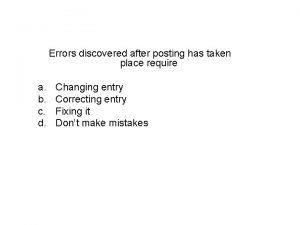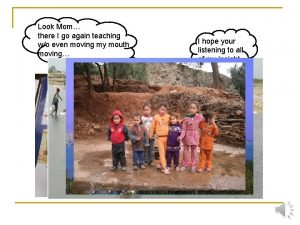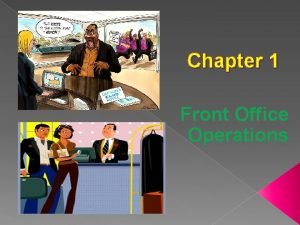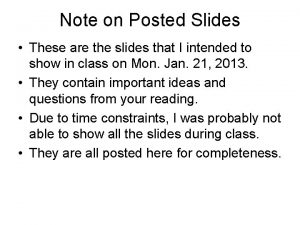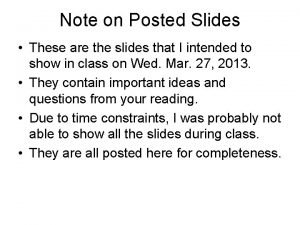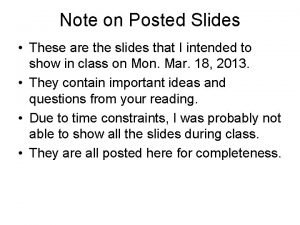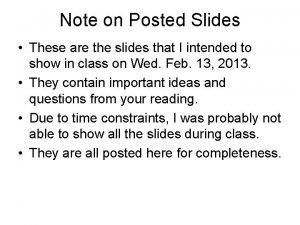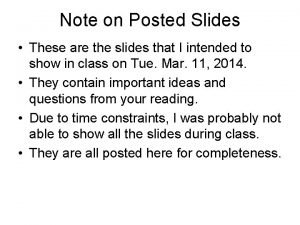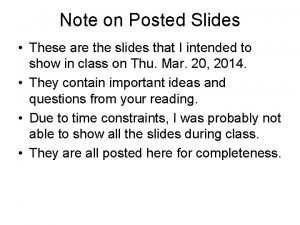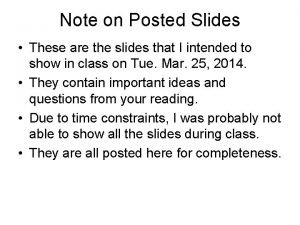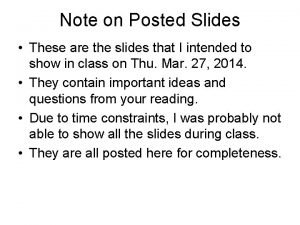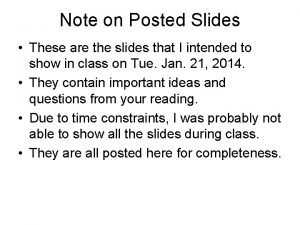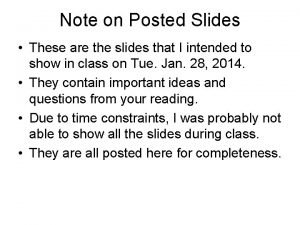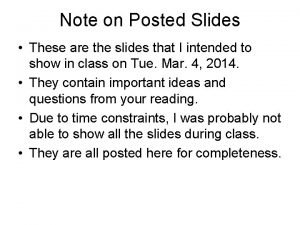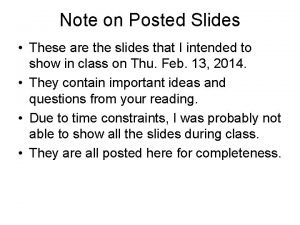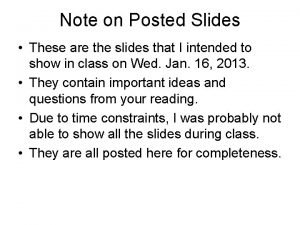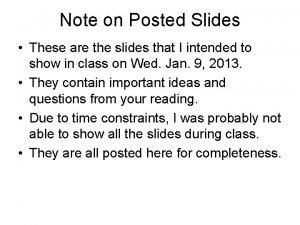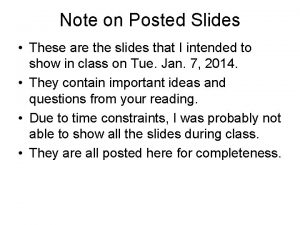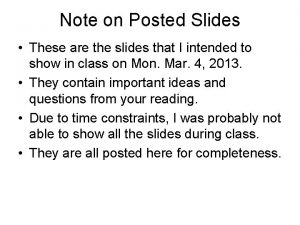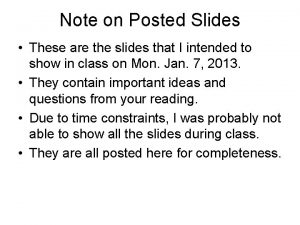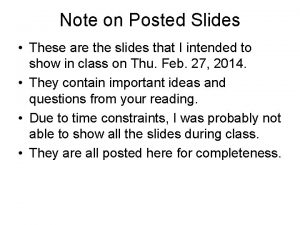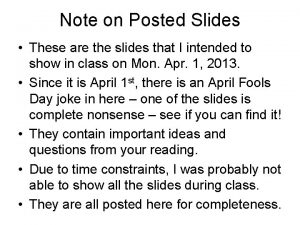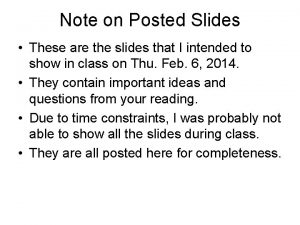Note on Posted Slides These are the slides













![Selective Transmission [image from http: //www. flickr. com/photos/ricardipus/3571089449/in/set-72157607219489528 ] Selective Transmission [image from http: //www. flickr. com/photos/ricardipus/3571089449/in/set-72157607219489528 ]](https://slidetodoc.com/presentation_image_h/2e23ada63039841f866efba302dbc908/image-14.jpg)





































- Slides: 51

Note on Posted Slides • These are the slides that I intended to show in class on Mon. Apr. 1, 2013. • Since it is April 1 st, there is an April Fools Day joke in here – one of the slides is complete nonsense – see if you can find it! • They contain important ideas and questions from your reading. • Due to time constraints, I was probably not able to show all the slides during class. • They are all posted here for completeness.

PHY 205 H 1 S Physics of Everyday Life Class 21: Colour • • Color in Our World Selective Reflection Selective Transmission Mixing Colored Light Mixing Colored Pigments Why the Sky Is Blue Why Sunsets Are Red Why Clouds Are White Egg image from http: //talesfromtherainbowroom. blogspot. ca/2011_05_01_archive. html

Recall from Chapters 25 and 26… § A changing electric field creates a magnetic field, which then changes in just the right way to recreate the electric field, which then changes in just the right way to again recreate the magnetic field, and so on. § This is an electromagnetic wave.

Radio Waves • In 1887, Hertz created radio waves with sparks • Radio Astronomy started in 1933 when Karl Jansky accidentally discovered Sagittarius A – the black hole at the centre of the Milky Way Galaxy Heinrich Hertz • Radio waves travel at the speed of light, and are used to transmit audio signals, video signals and digital information.

Microwaves • Polarized molecules can be excited via rotational modes, and so absorb heat when exposed to microwaves. • Microwave ovens use 2. 45 GHz, which is a good rotational resonance of the water molecule. • Microwaves are used in communication: cell phones, radio astronomy, communications with satellites. • No, your cell phone cannot popcorn.

Infrared • “Heat waves” – most molecules have lots of vibrational and rotational resonances in the IR • Room temperature objects emit blackbody radiation which peaks in the infrared. • Digital cameras can detect the near-infrared

Visible Light

Ultraviolet • Photon energies comparable to many chemical reactions. Mostly absorbed by ozone (O 3) in the stratosphere. • Can damage living tissue • Can cause materials to fluoresce: raises an electron to a high level, and then it emits energy by a series of downward jumps, each resulting in the emission of a lower energy photon.

X-rays • Discovered in 1895 by Röntgen • Tend to interact with inner electrons, nearer the nucleus of atoms: Calcium is a better absorber than Carbon because it has deeper electrons. • X-ray Astronomy is done with balloons and satellites: looks at stars and galaxies. Wilhelm Röntgen

Gamma Rays • Involved in nuclear reactions. • Pretty dangerous ionizing particles (along with beta and alpha) • Some gamma-ray astronomy: Gamma-Ray Bursters are intense, short bursts of gamma rays from extremely distant galaxies

Why Sunsets Are Red CHECK YOUR NEIGHBOR What property of a light wave mainly determines its colour? A. B. C. D. Its frequency Its amplitude Its timbre A mix of all of the above

Color we see depends on frequency of light. Low Frequency, Long wavelength High Frequency, Short wavelength

Selective Reflection A red ball seen under white light. under red light. Only red is reflected, other colors are absorbed. A red ball seen under green light. There is no source of red light to reflect!
![Selective Transmission image from http www flickr comphotosricardipus3571089449inset72157607219489528 Selective Transmission [image from http: //www. flickr. com/photos/ricardipus/3571089449/in/set-72157607219489528 ]](https://slidetodoc.com/presentation_image_h/2e23ada63039841f866efba302dbc908/image-14.jpg)
Selective Transmission [image from http: //www. flickr. com/photos/ricardipus/3571089449/in/set-72157607219489528 ]

Selective Transmission Color of transparent object depends on color of light it transmits.

Mixing Colored Light The spectrum of sunlight is a graph of brightness versus frequency. Some how, t his mix lo oks “white ” to us.

Why Sunsets Are Red CHECK YOUR NEIGHBOR A beam of white light, when shone through a prism, will end up many different colours. What will happen if a green laser is shone through a prism? A. It will spread into a small range of colours. B. It will change to a single colour other than green. C. It will stay green.

Rhodopsin is a transmembrane protein complex. Rods and cones contain stacks of membranes. Opsin (protein component) Cone Retinal (pigment) 0. 5 µm Rod Light Rhodopsin Light The retinal molecule inside rhodopsin changes shape when retinal absorbs light. trans conformation (activated) cis conformation (inactive) Opsin Light Slide courtesy of Ross Koning, Biology Department, Eastern Connecticut State University http: //plantphys. info/sciencematters/vision. ppt

Response Curves for the three types of cones in the retina of the human eye. Slide from http: //hyperphysics. phy-astr. gsu. edu/hbase/vision/colcon. html

Use both eyes, stare at area shown in blue for 15 seconds or so

What do you see on this blank white slide? Blink if needed! This is called an “after image” Does it move around as you move your gaze?

Use both eyes, stare at the parrot’s eye for 15 seconds or so Stare at the bird’s eye for 10 seconds without tilting your head.

Bird Was Red What colour is the afterimage bird? A. orange B. green C. blue D. yellow E. None of the above

Use both eyes, stare at the parrot’s eye for 15 seconds or so Stare at the bird’s eye for 10 seconds without tilting your head.

Bird Was Green What colour is the afterimage bird? A. red B. orange C. blue D. violet E. None of the above

Use both eyes, stare at the parrot’s eye for 20 seconds or so Stare at the bird’s eye for 10 seconds without tilting your head.

Bird Was Blue What colour is the afterimage bird? A. red B. orange C. yellow D. green E. None of the above

• For artists using paint, red blue and yellow are the useful primary colours. • Note that this is different than the RGB additive primaries used in computer screens! • The “opposite” colours match well with my experience of the after-image in the previous slides. Image is from Designedly, Kristi http: //www. designedlykristi. com/tutorials/color_intro/color_theory 2. html

Additive Primary Colours (light bulbs) and Subtractive Primary Colours (ink)

Discussion Question • Why is this square red? A. The light bulbs in the projector emit light with blue frequencies B. The light bulbs in the projector emit light with green frequencies C. The light bulbs in the projector emit light with red frequencies D. Both A and B

Discussion Question • Why is the red folder in Harlow’s hand red? A. The pigments in the paper absorb light with blue frequencies B. The pigments in the paper absorb light with green frequencies C. The pigments in the paper absorb light with red frequencies D. Both A and B

The shadows of the golf ball are the “subtractive primary colors”. • Cyan (opposite of red): • Magenta (opposite of green) • Yellow (opposite of blue)


Only four colors of ink are used to print color photographs: magenta, yellow, cyan and black.

Discussion Question : Using the colour wheel. . • When the colour yellow is seen on the screen of your computer, what are the lights being activated in that region of your screen? A. Mainly yellow B. Blue and red C. Green and yellow D. Red and green

Discussion Question : Using the colour wheel. . • If an object is blue, which of the coloured lights below would make the object appear most black? A. blue B. cyan C. yellow D. magenta

Discussion Question : Using the colour wheel. . • If an object is red, which of the coloured lights below would make the object appear not appear red? A. red B. orange C. white D. cyan

“Daddy, why is the sky blue? ” • Rayleigh scattering is elastic scattering of light by particles much smaller than the wavelength of light. • Scattering intensity is proportional to f 4 • So, higher frequency blue light is scattered much more readily than lower frequency red light. John William Strutt, 3 rd Baron Rayleigh • You see blue light coming from all directions in the sky, as long as there is sunlight passing through the air above you.

Why the Sky Is Blue For small scattering particles, like nitrogen or oxygen molecules, higher frequency blue light is scattered much more readily than lower frequency red light.

Why the Sky Is Blue

Why Sunsets Are Red CHECK YOUR NEIGHBOUR If molecules in the sky scattered orange light instead of blue light, the sky would be A. B. C. D. orange. yellow. green. blue.

Doppler Shift for Light • When a light source is moving away from you, the spectrum is shifted toward the red. • When a light source is moving toward you, the spectrum is shifted toward the blue.

Doppler Shift for Light • The Doppler shift can be observed in the headlights of cars on the highway. • The cars moving away from you appear more red, while the cars moving toward you appear more blue-ish or white.

Doppler Shift for Light (yes, really!) • The Doppler shift can be observed with carefully obtained spectra of very fast moving objects like stars • There is a slight shift in “absorption lines”

Why Sunsets Are Red Light that is least scattered is light of low frequencies, which best travel straight through air.

Why Sunsets Are Red CHECK YOUR NEIGHBOUR If molecules in the sky scattered orange light instead of blue light, sunsets would be A. B. C. D. orange. yellow. green. blue.

Why Clouds Are White • Clouds are clusters of various sizes of water droplets

Why Clouds Are White Size of clusters determines scattered cloud color. • • • Tiny clusters produce bluish clouds. Slightly large clusters produce greenish clouds. Larger clusters produce reddish clouds. Overall result is white clouds. Slightly larger clusters produce a deep gray. Still larger clusters produce raindrops.

Why Sunsets Are Red CHECK YOUR NEIGHBOR What does a white sky indicate? A. The atmosphere has mostly particles smaller than the wavelength of light B. The atmosphere has mostly particles larger than the wavelength of light C. The atmosphere has a mixture of particle sizes D. The atmosphere has a lot of water vapour E. The atmosphere is filled with pollutants.

Why Water Is Greenish Blue • Water molecules resonate somewhat in the visible red, which causes red light to be a little more strongly absorbed in water than blue light. • Red light is reduced to one-quarter of its initial brightness by 15 meters of water. There is very little red light in the sunlight that penetrates below 30 meters of water. • When red is removed from white light, the complementary color of red remains: cyan—a bluish-green color.

Before class on Wednesday – the LAST CLASS!!!! • Please read Chapter 28, or at least watch the 10 -minute pre-class video for class 22. • Something to think about: • What is the difference between a real image and a virtual image?
 Insidan region jh
Insidan region jh Goods received note
Goods received note Simple interest note vs simple discount note
Simple interest note vs simple discount note Difference between note making and note taking
Difference between note making and note taking Debit note example
Debit note example Examples of signal words
Examples of signal words Debit note format
Debit note format Difference between note making and note taking
Difference between note making and note taking Relevance of note making
Relevance of note making Errors discovered after posting has taken place requires
Errors discovered after posting has taken place requires What is an infrared thermometer best used for servsafe
What is an infrared thermometer best used for servsafe Post the journal’s special amount column totals.
Post the journal’s special amount column totals. Signage posted at a handwashing station must include
Signage posted at a handwashing station must include Look mom i posted it again
Look mom i posted it again Posted voucher rack
Posted voucher rack Posted
Posted A small child slides down the four frictionless slides
A small child slides down the four frictionless slides A spring loaded gun shoots a plastic ball
A spring loaded gun shoots a plastic ball These slides
These slides These slides
These slides Teacher gists
Teacher gists Bổ thể
Bổ thể Tư thế ngồi viết
Tư thế ngồi viết V. c c
V. c c Thẻ vin
Thẻ vin Thể thơ truyền thống
Thể thơ truyền thống Các châu lục và đại dương trên thế giới
Các châu lục và đại dương trên thế giới Hát lên người ơi alleluia
Hát lên người ơi alleluia Khi nào hổ mẹ dạy hổ con săn mồi
Khi nào hổ mẹ dạy hổ con săn mồi Từ ngữ thể hiện lòng nhân hậu
Từ ngữ thể hiện lòng nhân hậu Diễn thế sinh thái là
Diễn thế sinh thái là Vẽ hình chiếu vuông góc của vật thể sau
Vẽ hình chiếu vuông góc của vật thể sau 101012 bằng
101012 bằng Tỉ lệ cơ thể trẻ em
Tỉ lệ cơ thể trẻ em Lời thề hippocrates
Lời thề hippocrates đại từ thay thế
đại từ thay thế Quá trình desamine hóa có thể tạo ra
Quá trình desamine hóa có thể tạo ra Cong thức tính động năng
Cong thức tính động năng Môn thể thao bắt đầu bằng từ đua
Môn thể thao bắt đầu bằng từ đua Khi nào hổ con có thể sống độc lập
Khi nào hổ con có thể sống độc lập Thế nào là mạng điện lắp đặt kiểu nổi
Thế nào là mạng điện lắp đặt kiểu nổi Hình ảnh bộ gõ cơ thể búng tay
Hình ảnh bộ gõ cơ thể búng tay Các loại đột biến cấu trúc nhiễm sắc thể
Các loại đột biến cấu trúc nhiễm sắc thể Vẽ hình chiếu đứng bằng cạnh của vật thể
Vẽ hình chiếu đứng bằng cạnh của vật thể Nguyên nhân của sự mỏi cơ sinh 8
Nguyên nhân của sự mỏi cơ sinh 8 Phản ứng thế ankan
Phản ứng thế ankan Voi kéo gỗ như thế nào
Voi kéo gỗ như thế nào Thiếu nhi thế giới liên hoan
Thiếu nhi thế giới liên hoan điện thế nghỉ
điện thế nghỉ Một số thể thơ truyền thống
Một số thể thơ truyền thống Thế nào là hệ số cao nhất
Thế nào là hệ số cao nhất Trời xanh đây là của chúng ta thể thơ
Trời xanh đây là của chúng ta thể thơ









